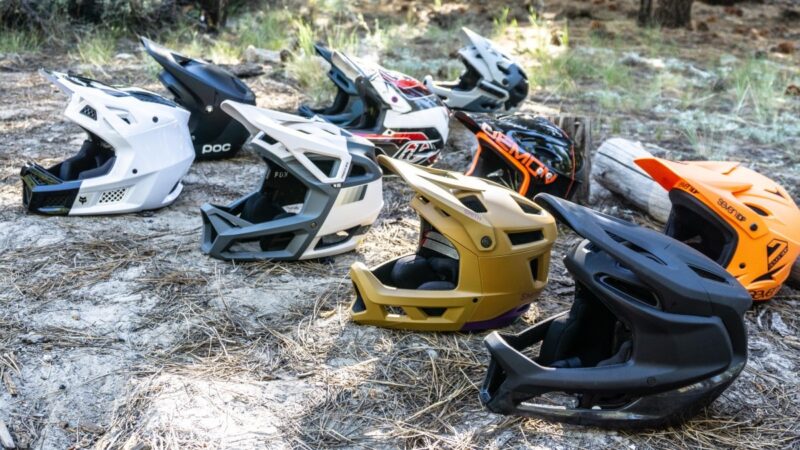When it comes to mountain biking, especially on technical descents, downhill trails, or in bike parks, your head’s protection should never be compromised. Full-face mountain bike helmets represent the gold standard in cranial protection for riders tackling challenging terrain at high speeds.
With technology evolving rapidly in 2025, today’s helmets offer unprecedented levels of safety, comfort, and performance. This comprehensive guide will walk you through everything you need to know to select the perfect full-face helmet that matches your riding style, safety requirements, and comfort preferences.
Why Full-Face Protection Matters for Mountain Biking
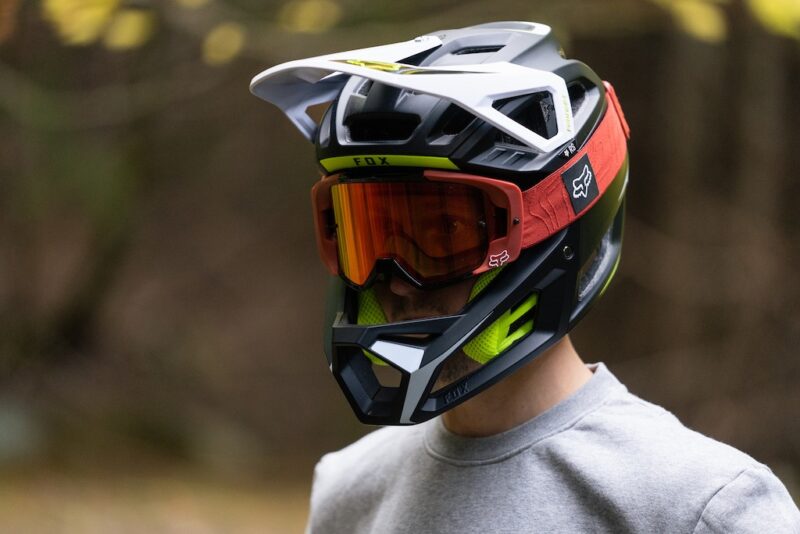
Full-face mountain bike helmets provide comprehensive protection that extends beyond what traditional half-shell helmets offer. With coverage for your entire head, including the jaw, face, and chin, these helmets are specifically designed to protect against the unique impacts and hazards encountered during aggressive mountain biking.
Full-face helmets provide critical protection for technical descents and high-speed riding
The statistics speak for themselves: studies show that full-face helmets reduce head injury risk by over 60% compared to no helmet, and significantly outperform half-shell designs in protecting against facial injuries.
With mountain biking pushing into more technical terrain and bike technology enabling higher speeds than ever before, the case for full-face protection has never been stronger.
When You Need a Full-Face Helmet: Downhill riding, bike park sessions, enduro racing, technical trail riding with significant drops or jumps, or any situation where falls could result in facial impact.
Types of Full-Face Mountain Bike Helmets in 2025
The full-face helmet market has evolved significantly, with several distinct categories emerging to meet different riding styles and needs:
Downhill/Freeride Helmets
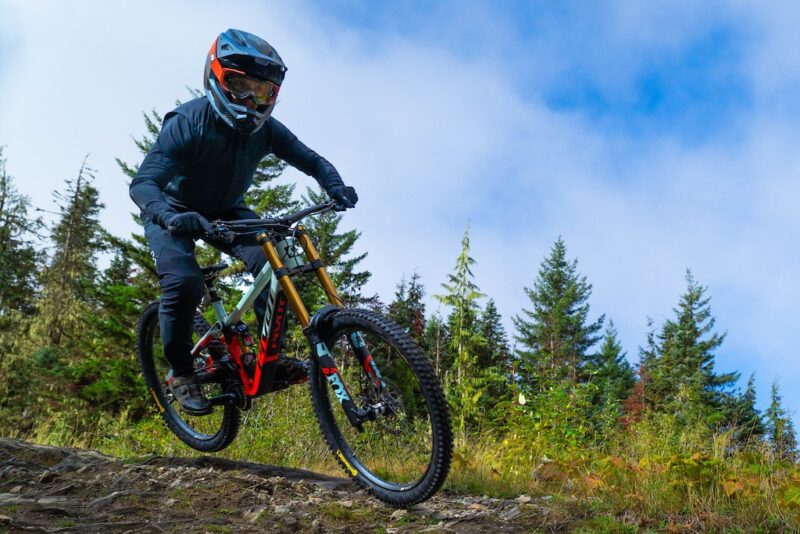
The most robust option, designed for maximum protection during high-speed descents, big drops, and technical terrain. These helmets prioritise safety over ventilation and are typically heavier with more substantial padding and reinforcement.
Enduro Full-Face Helmets
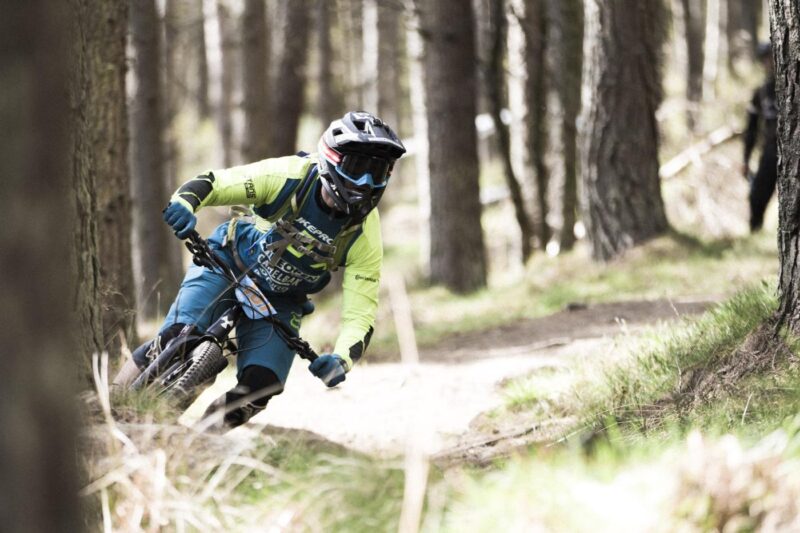
Striking a balance between protection and breathability, these helmets are lighter than downhill models while maintaining full-face coverage. Perfect for riders who need protection but also pedal uphill frequently.
Convertible Full-Face Helmets
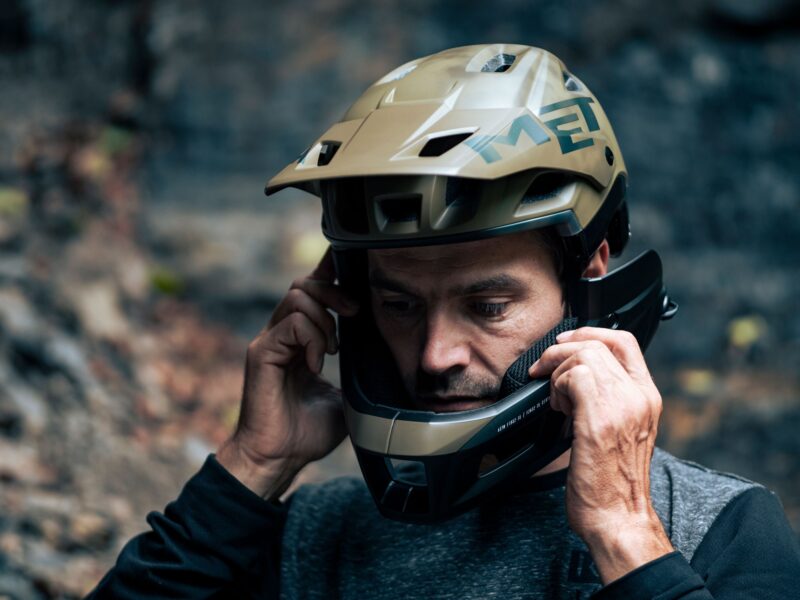
These innovative 2-in-1 designs feature a removable chin bar, allowing riders to switch between full-face protection for descents and open-face configuration for climbs. Ideal for trail riders who encounter varied terrain.
Your riding style should dictate which category best suits your needs. For dedicated downhill or bike park riders, a traditional downhill helmet like the iXS Trigger Full Face MIPS offers the comprehensive protection needed for high-speed riding. Trail riders who occasionally visit bike parks might prefer the versatility of a lightweight enduro full-face or convertible option.
And with BikesOnline AU and BikesOnline US running their Black Friday Bike Sale, now’s the best time to upgrade your gear. You can score premium full-face helmets, protective wear, and riding accessories at unbeatable prices — giving you maximum safety and performance without breaking the bank.
Shop the Black Friday Bike Sale at BikesOnline AU or BikesOnline US and gear up for your next adventure!
Safety Standards and Certifications
When evaluating full-face helmets, understanding safety certifications is crucial. These standards ensure the helmet has passed rigorous testing for impact protection.
| Certification | Description | Application |
| ASTM F1952 | Specific standard for downhill mountain biking helmets | Highest level of protection for aggressive riding |
| CE EN 1078 | European standard for bicycle helmets | Basic safety requirement for all bike helmets |
| CPSC | Consumer Product Safety Commission (US) | Required for all helmets sold in the United States |
| AS/NZS 2063 | Australia/New Zealand standard | Required for helmets sold in Australia/NZ |
For serious mountain biking, look for helmets that meet the ASTM F1952 standard, which specifically tests for the demands of downhill riding. The iXS Trigger Full Face MIPS Helmet, available at BikesOnline, meets all major safety certifications including the rigorous ASTM F1952 standard, ensuring maximum protection for aggressive riding.
Always check for proper safety certifications when selecting a full-face helmet
MIPS vs. Non-MIPS Technology: Understanding the Difference
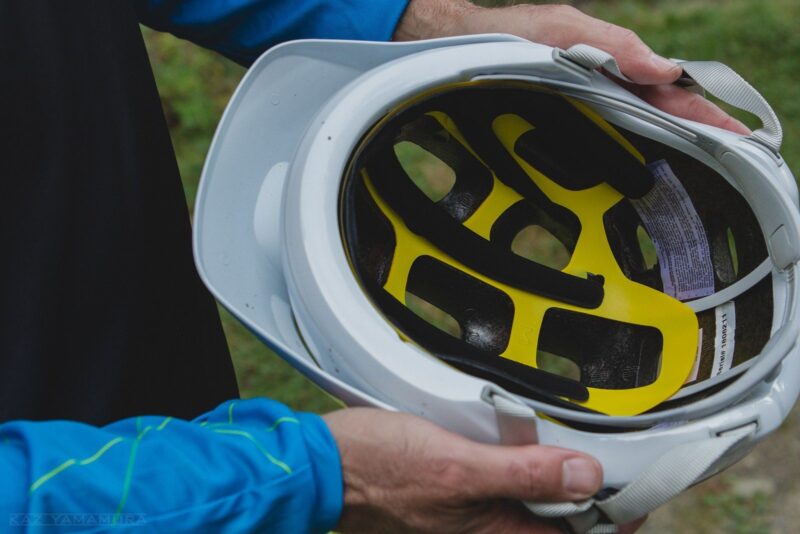
One of the most significant advancements in helmet safety is MIPS (Multi-directional Impact Protection System) technology, which has become increasingly standard in premium helmets.
How MIPS Works
MIPS consists of a low-friction layer between the helmet’s shell and liner that allows the helmet to rotate slightly (10-15mm) relative to the head during an angled impact. This rotation redirects rotational forces that would otherwise transfer to the brain, potentially reducing the risk of concussions and brain injuries.
Research indicates that most bike crashes involve angled impacts rather than direct hits. MIPS technology specifically addresses these real-world crash scenarios by allowing the helmet to absorb and redirect rotational energy that traditional helmets cannot.
MIPS technology creates a slip plane that allows the helmet to rotate slightly during impact
MIPS Advantages
- Reduces rotational forces transferred to the brain
- Addresses real-world crash scenarios with angled impacts
- Minimal weight addition (typically 25-45g)
- Scientifically tested and proven technology
- Becoming standard in premium helmets
MIPS Considerations
- Adds some cost to helmet price
- Slight reduction in ventilation in some designs
- May affect helmet fit for some head shapes
- Requires proper sizing to function effectively
The iXS Trigger Full Face MIPS Helmet features an advanced implementation of MIPS technology that seamlessly integrates with the helmet’s design. The system is virtually unnoticeable when wearing the helmet but provides crucial protection during impacts. BikesOnline offers this helmet with the latest 2025 MIPS integration, representing a significant advancement over older designs.
Experience Advanced MIPS Protection
The iXS Trigger Full Face MIPS Helmet offers state-of-the-art rotational impact protection for demanding mountain bike trails.
Weight Considerations for Full-Face Helmets

The weight of your full-face helmet significantly impacts comfort, especially during longer rides. Traditionally, full-face helmets were substantially heavier than their half-shell counterparts, but advancements in materials and design have dramatically reduced weight while maintaining protection.
Modern lightweight full-face helmets (left) offer significant weight savings compared to traditional designs (right)
Material Impact on Weight
The primary materials used in full-face helmet construction include:
| Material | Weight Impact | Protection Level | Price Point |
| Polycarbonate Shell | Moderate | Good | Entry to Mid |
| Fiberglass Composite | Moderate-Light | Very Good | Mid-Range |
| Carbon Fiber | Very Light | Excellent | Premium |
| Carbon-Kevlar Blend | Light | Excellent | Premium |
For 2025, most premium full-face helmets fall into these weight categories:
- Downhill/Freeride: 900-1200g
- Enduro Full-Face: 700-900g
- Convertible: 750-950g
The iXS Trigger Full Face MIPS Helmet strikes an impressive balance at approximately 850g (size M), placing it in the lightweight category for a full-protection helmet. This weight reduction is achieved through advanced composite shell technology without compromising on safety standards.
Weight Distribution Matters: Beyond the total weight, how that weight is distributed affects comfort. The iXS Trigger features balanced weight distribution that reduces neck fatigue during long rides.
Ventilation Systems in Full-Face Helmets
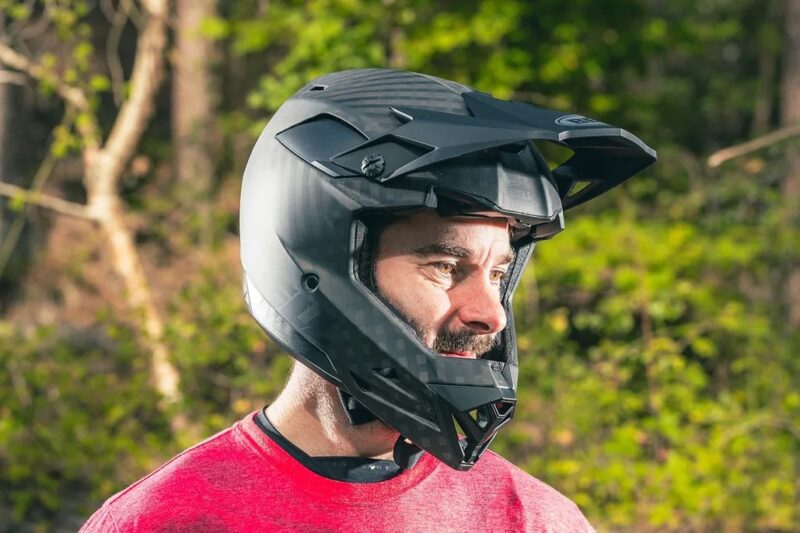
Adequate ventilation is crucial for full-face helmets, especially for riders who climb or pedal extensively. Modern full-face designs have revolutionized airflow compared to earlier models that were notoriously hot and stuffy.
Advanced ventilation systems use strategically placed intake and exhaust ports to maximize airflow
Key Ventilation Features to Consider
- Number and Size of Vents: More and larger vents typically mean better airflow, though this can affect structural integrity
- Vent Placement: Strategic positioning of intake vents (front) and exhaust ports (rear) creates effective airflow channels
- Internal Channeling: Internal air channels direct airflow across the head
- Chin Bar Ventilation: Critical for breathing comfort and preventing visor fogging
- Removable Components: Some helmets offer removable cheek pads or mouth guards for additional cooling during climbs
The 2025 iXS Trigger Full Face MIPS Helmet features 20 strategically placed vents that create a constant airflow path through the helmet. The innovative chin bar design incorporates mesh-covered vents that prevent debris entry while maximizing breathability. This ventilation system makes it suitable for enduro riding where both climbing and descending are required.
Stay Cool Under Pressure
Experience the superior ventilation of the iXS Trigger Full Face MIPS Helmet on your next ride.
Finding the Perfect Fit: Comfort and Adjustability
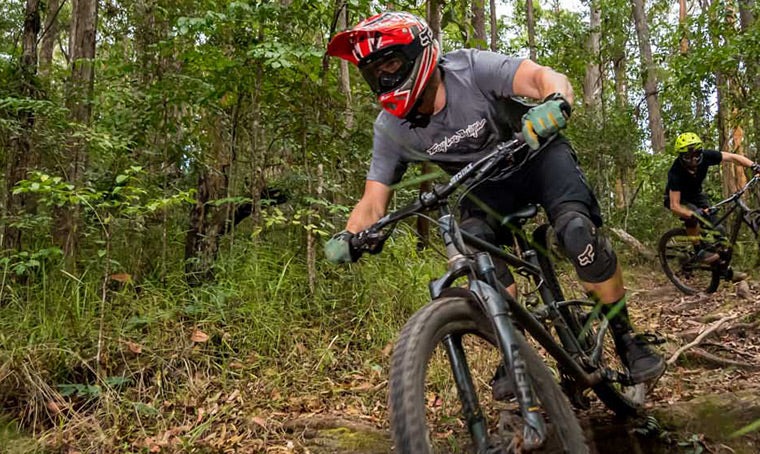
A properly fitting full-face helmet is essential not only for comfort but also for safety. Even the most advanced helmet won’t protect you adequately if it doesn’t fit correctly.
A properly fitted full-face helmet should sit level and feel secure without pressure points
How to Measure for the Right Size
To find your correct helmet size:
- Wrap a flexible measuring tape around your head about 1 inch above your eyebrows and ears
- Measure the circumference in centimeters
- Compare your measurement to the manufacturer’s size chart
- If between sizes, try both or opt for the larger size if you’ll use a liner
Key Fit Components
Retention Systems
Modern full-face helmets feature various adjustment systems:
- Dial-Fit Systems: Allow precise circumference adjustment
- Adjustable Cheek Pads: Customize the fit around your face
- Removable Padding: Different thickness options for customization
- Strap Dividers: Position straps properly around ears
Comfort Features
Look for these elements to enhance long-ride comfort:
- Moisture-Wicking Liners: Keep sweat away from your face
- Antimicrobial Treatments: Prevent odor buildup
- Removable/Washable Padding: Maintain hygiene
- Emergency Release Systems: Allow safe removal in case of injury
The iXS Trigger Full Face MIPS Helmet excels in adjustability with its FidLock magnetic buckle system for easy on/off even with gloves, and multiple pad thickness options included for a customized fit. The helmet’s ergonomic shape accommodates various head profiles, while the emergency cheek pad release system provides added safety in case of a crash.
The iXS Trigger features multiple adjustment points for a customized fit
Visor Design and Goggle Compatibility
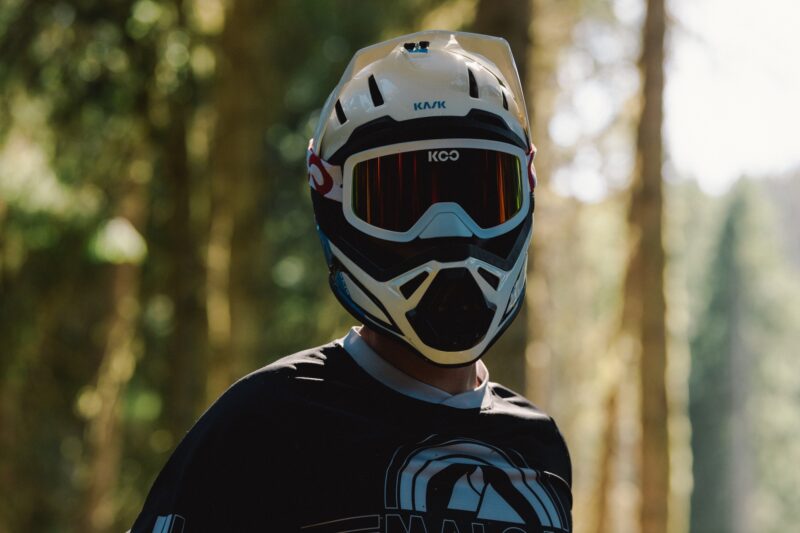
A well-designed visor and proper goggle compatibility are essential for visibility and protection while riding.
Proper visor and goggle integration ensures clear vision in varying conditions
Visor Considerations
- Adjustability: Look for visors with multiple positions to accommodate different riding conditions and goggle placement
- Breakaway Design: Safety feature that allows the visor to detach during a crash to prevent neck injuries
- Width and Length: Should provide adequate sun and debris protection without limiting visibility
- Tool-less Adjustment: Allows quick changes while on the trail
Goggles Integration
Full-face helmets should be designed with goggle compatibility in mind:
- Goggle Channel: A recessed area at the back of the helmet to secure the goggle strap
- Visor Clearance: Adequate space to position goggles under the visor when not in use
- Face Port Size: Large enough to accommodate various goggle brands and styles
The iXS Trigger Full Face MIPS Helmet features a three-position adjustable visor with tool-less adjustment and breakaway functionality. The helmet’s face port is designed to accommodate most goggle brands, and the rear goggle channel securely holds the strap in place during aggressive riding.
Additional Features Worth Considering
Beyond the core elements, several additional features can enhance your full-face helmet experience:
Camera Mounts

Many modern helmets include integrated camera mount points for action cameras. These are designed to break away during impacts to prevent the camera from causing injury. The iXS Trigger includes a flat mount area compatible with GoPro and similar camera systems.
Communication Systems
Some helmets feature recessed areas to accommodate Bluetooth communication devices. This allows riders to stay connected with riding partners or listen to navigation instructions without compromising the helmet’s integrity.
Emergency Features
Advanced safety features like emergency ID chips, quick-release cheek pads for first responders, and helmet crash sensors are becoming more common in premium helmets for 2025.
Modern full-face helmets incorporate numerous technology integrations beyond basic protection
Price Considerations and Value Assessment
Full-face mountain bike helmets span a wide price range, from entry-level options around $100 to premium models exceeding $500. Understanding what you get at different price points helps make an informed decision.
| Price Range | Expected Features | Best For |
| $100-200 | Basic protection, limited ventilation, heavier materials, simpler adjustment systems | Occasional riders, beginners, bike park visitors on a budget |
| $200-350 | MIPS or similar technology, improved ventilation, better fit systems, lighter materials | Regular riders seeking balance of performance and value |
| $350-500+ | Premium materials (carbon fiber), advanced safety features, optimal ventilation, customizable fit | Dedicated riders, racers, those seeking maximum protection and comfort |
The iXS Trigger Full Face MIPS Helmet sits in the mid-premium range, offering exceptional value with features typically found in more expensive helmets. BikesOnline frequently offers competitive pricing on this model, making advanced protection more accessible.
“When it comes to protecting your brain, value doesn’t necessarily mean buying the cheapest option. Consider how frequently you ride, the terrain you tackle, and how long you’ll keep the helmet before making your decision.”
– Professional Mountain Bike Coach
Maintenance and Replacement Guidelines
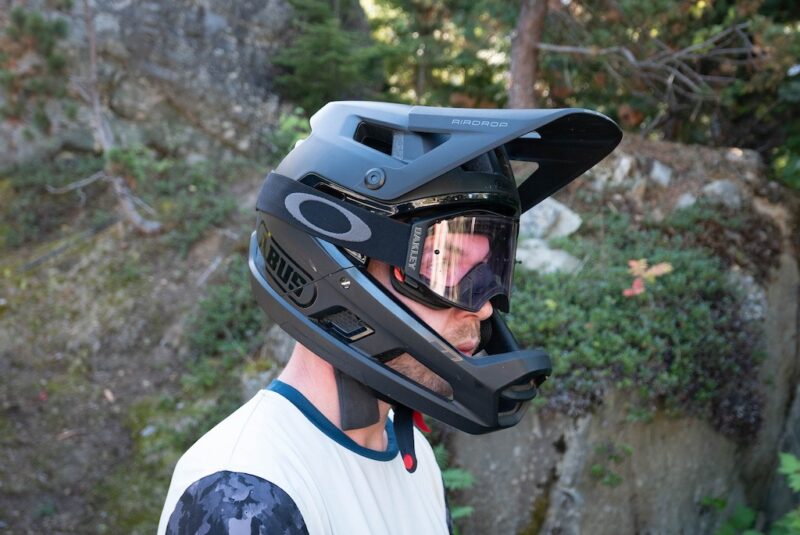
Proper maintenance extends your helmet’s lifespan, while knowing when to replace it ensures continued protection.
Regular cleaning and proper storage extend your helmet’s functional lifespan
Maintenance Best Practices
- Clean with mild soap and water only; avoid chemical cleaners
- Remove and wash padding according to manufacturer instructions
- Store in a cool, dry place away from direct sunlight
- Avoid hanging by straps, which can stretch them over time
- Periodically check for loose screws or damaged components
When to Replace Your Helmet
Critical Safety Information: Always replace your helmet after any significant impact, even if no visible damage is present. The EPS foam compresses during impacts, reducing future protection capability.
Even without crashes, manufacturers recommend replacing helmets every 3-5 years as materials degrade from exposure to UV light, sweat, and regular use. The adhesives and EPS foam can deteriorate over time, compromising safety.
Expert Buying Tips for 2025
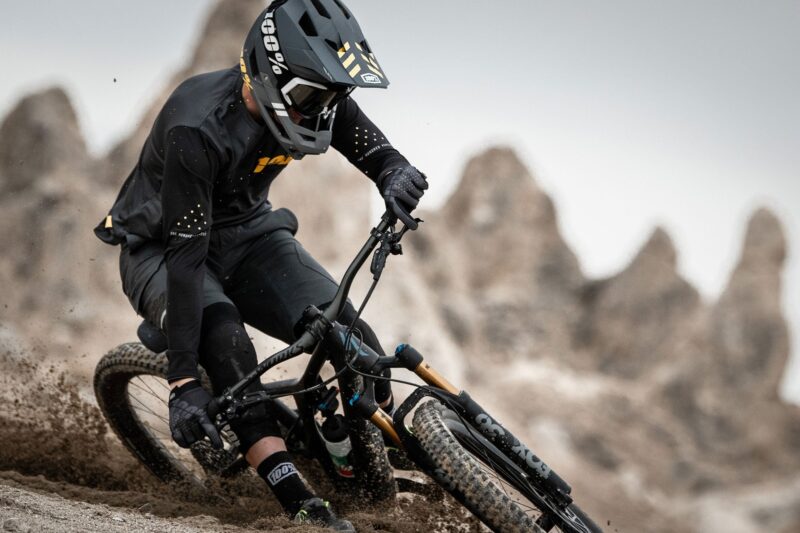
Follow these expert recommendations to make the most informed full-face helmet purchase:
Whenever possible, try on multiple helmets to find your perfect fit
- Try Before You Buy: If possible, visit a local retailer to try different models and sizes
- Consider Your Riding Style: Match helmet type to your typical terrain and riding intensity
- Prioritize Safety Features: MIPS or equivalent technology should be non-negotiable for serious riders
- Check Certification Labels: Ensure the helmet meets appropriate safety standards for your riding style
- Evaluate Ventilation Needs: Consider your local climate and how much climbing you’ll do
- Read User Reviews: Look for feedback from riders with similar head shapes and riding styles
- Shop Reputable Retailers: Purchase from established bike shops or trusted online retailers like BikesOnline
Ready to Upgrade Your Protection?
BikesOnline offers the iXS Trigger Full Face MIPS Helmet with expert fitting advice and satisfaction guarantee.
Frequently Asked Questions
Can I use a full-face helmet for regular trail riding?
Absolutely. While full-face helmets were traditionally reserved for downhill and bike park riding, the newer lightweight designs like the iXS Trigger Full Face MIPS are perfectly suitable for trail riding, especially on technical terrain. The improved ventilation and reduced weight make them comfortable even for pedaling sections.
How do I know if my full-face helmet fits correctly?
A properly fitting full-face helmet should:
- Sit level on your head without tilting forward or backward
- Feel snug but not painfully tight
- Not move more than an inch in any direction when secured
- Have cheek pads that contact your face without excessive pressure
- Allow you to fit two fingers between the chin strap and your throat
If you can move the helmet significantly or feel pressure points, try a different size or model.
Is MIPS technology worth the additional cost?
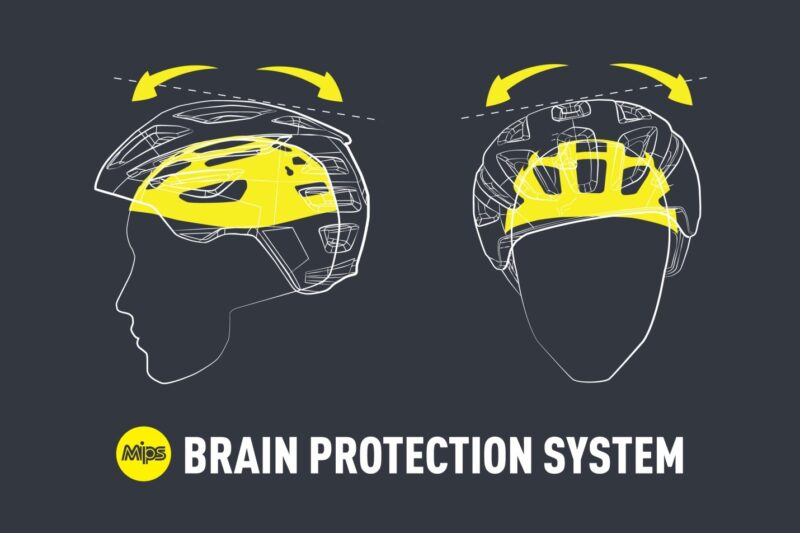
Research strongly suggests that MIPS technology provides valuable additional protection against rotational forces that can cause brain injuries. Given that the price difference is typically $20-50 more than non-MIPS versions of the same helmet, most experts consider it a worthwhile investment for the potential safety benefits. The iXS Trigger Full Face MIPS Helmet incorporates this technology seamlessly without significant weight penalties.
How do full-face helmets affect hearing and awareness on the trail?
Full-face helmets do reduce ambient sound compared to open helmets, but modern designs like the iXS Trigger are engineered to minimize this effect. Most riders quickly adapt to the slightly muffled sound environment. Some helmets feature ear channels specifically designed to improve hearing. For group rides, consider using hand signals to supplement verbal communication.
Conclusion: Making Your Final Decision
Choosing the right full-face mountain bike helmet in 2025 involves balancing safety features, comfort, weight, ventilation, and value. By understanding the technologies and features available, you can make an informed decision that best suits your riding style and protection needs.
Remember that the best helmet is one that you’ll wear consistently. Even the most advanced helmet can’t protect you if it’s too uncomfortable to wear or left at home because it’s too hot or heavy. The iXS Trigger Full Face MIPS Helmet represents an excellent balance of all key factors, making it a standout option for riders seeking comprehensive protection without compromising on comfort or performance.
BikesOnline offers a wide selection of full-face helmets, including the iXS Trigger, with expert advice to help you find your perfect match. Investing in quality head protection is one of the most important decisions you can make as a mountain biker—your brain is worth it.
With the right helmet, you can ride with confidence and focus on the trail ahead
Protect What Matters Most
Discover why the iXS Trigger Full Face MIPS Helmet is the choice of serious mountain bikers in 2025.
